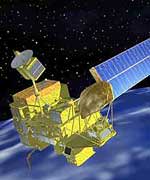
Image credit: JAXA
Ground controllers have lost contact with Midori 2, a $587 million environmental research satellite launched in December last year. The Japanese/US spacecraft didn’t check in on Saturday when it flew over a ground station; shortly after that it went into safe mode, and then all telemetry was lost. Controllers are trying to recover contact with the satellite, but it will probably be difficult because it’s not even sending out telemetry data. Midori 2 was supposed to last at least 3 years and use five scientific instruments to gather data about water vapour, ocean winds, sea temperatures, sea ice, and marine vegetation.
The Japan Aerospace Exploration Agency (JAXA) failed to receive earth observation data from its Advanced Earth Observing Satellite II, Midori-II, at its Earth Observation Center in Saitama Prefecture at 7:28 a.m. on October 25, 2003 (Japan Standard Time, JST). At 8:49 a.m. (JST), JAXA checked the operational status of Midori-II, and found it was switched to a light load mode (in which all observation equipment is automatically turned off to minimize power consumption) due to an unknown anomaly. Around 8:55 a.m. (JST), communications between the satellite and ground stations became unstable, and telemetry data was not received.
JAXA’s Katsuura Tracking and Communication Station also failed to receive telemetry data twice (9:23 and 11:05 a.m. JST.)
JAXA is currently analyzing earlier acquired telemetry data. The analysis of power generation data by the solar array paddle revealed that generated power has decreased from 6kW to 1kW.
We are doing our utmost to have Midori-II return to normal operation mode by continuing to analyze telemetry data and by working to understand the current condition of the satellite at our domestic and overseas tracking stations.
JAXA formed the ?Midori-II anomaly investigation team,? led by the president of JAXA, to lead the investigation.
Original Source: JAXA News Release
